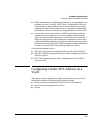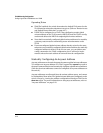
4-11
IPv6 Addressing Configuration
Configuring a Static IPv6 Address on a VLAN
■ DHCPv6 and statically configured global unicast or anycast addresses are
mutually exclusive on a given VLAN. That is, configuring DHCPv6 on a
VLAN erases any static global unicast or anycast addresses previously
configured on that VLAN, and the reverse. (A statically configured link-
local address will not be affected by configuring DHCPv6 on the VLAN.)
■ For the same subnet on the switch, a DHCPv6 global unicast address
assignment takes precedence over an autoconfigured address assign-
ment, regardless of which address type was the first to be configured. If
DHCPv6 is subsequently removed from the configuration, then an auto-
configured address assignment will replace it after the next router adver-
tisement is received on the VLAN. DHCPv6 and autoconfigured addresses
co-exist on the same VLAN if they belong to different subnets.
For related information refer to:
■ RFC 3315: “Dynamic Host Configuration Protocol for IPv6 (DHCPv6)”
■ RFC 3633: “IPv6 Prefix Options for Dynamic Host Configuration Protocol
(DHCP) version 6”
■ RFC 3736: “Stateless Dynamic Host Configuration Protocol (DHCP)
Service for IPv6”
Configuring a Static IPv6 Address on a
VLAN
This option enables configuring of unique, static unicast and anycast IPv6
addresses for global and link-local applications, including:
■ link-local unicast (including EUI and non-EUI device identifiers)
■ global unicast (and unique local unicast)
■ anycast


















